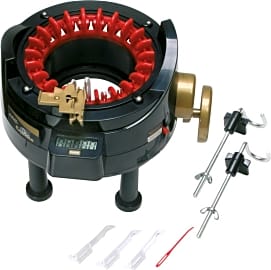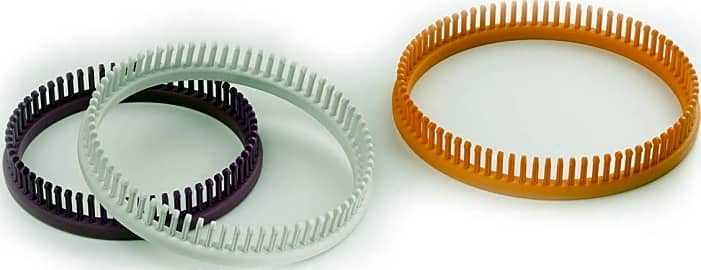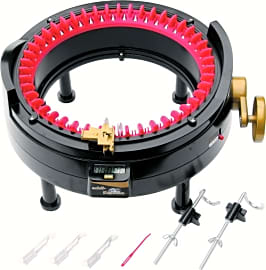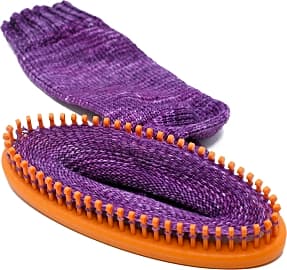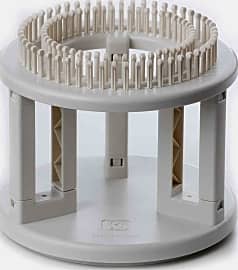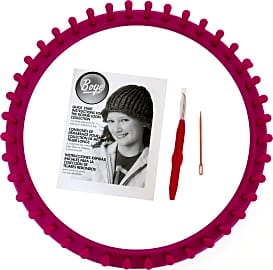The 10 Best Knitting Machines And Looms

This wiki has been updated 41 times since it was first published in June of 2016. Anyone who’s ever tried knitting knows that it can be fun, relaxing, and rewarding. But in today’s hurry-up world, it can be difficult to find the time. That’s where our selection of knitting looms and machines comes in. These nifty little gadgets help you produce hats, scarves, blankets, and sweaters more rapidly than you can with just needles. Most are even simple enough that kids can use them. When users buy our independently chosen editorial choices, we may earn commissions to help fund the Wiki.
Editor's Notes
December 26, 2019:
Currently, the Clover Standing Oval and D&D Professional have become difficult to find, so we have opted to remove them. But many popular options from KB are still available, including the KB All-n-One, a wood choice that feels good in the hands, and the KB Premium, a simple option that won't be overwhelming for beginners. But we added the Readaeer Round Set as an alternative to this latter choice; it comes with one more loom as well as nifty pompon makers, and for a lower price. For those who don't mind investing a bit more, the Addi Express Professional and Addi Express King Size remain viable options, both with an integrated row counter that will help you keep your place. Finally, we opted to add the KB His and Her Sock. It allows you to create two sizes of adult socks, but these sizes aren't actually adjustable, so the finished socks won't necessarily fit everyone. Still, it's a great alternative for those who might not be ready for making socks with a regular knitting needle set.
Special Honors
Silver Reed LK-150 If you have the money to invest, and the time to learn how to use it, the Silver Reed LK-150 can take your machine knitted creations to whole new levels. You'll be able to achieve various types of fabric, including stockinette, and work with yarns from medium weight to bulky. lionbrand.com
Fun Times Are Looming
When you use a round loom, you can make circular pieces, including hats, socks, mittens, Christmas stockings, and sweaters you don’t have to seam.
Loom knitting is a type of handcrafting that relies on a piece of equipment with pegs to produce stitches, rather than the two needles used in hand knitting. In some cases, loom knitting is viewed as less useful than traditional hand knitting. For instance, it’s sometimes seen as something for kids to do. While it’s true that loom knitting can be a great craft for kids, there’s no reason it has to be an inferior activity. Loom knitters can make nearly as many types of objects as other knitters can, from small socks to large sweaters.
One benefit of loom knitting is that, if you don’t already know how to do it, you can probably learn in about 10 minutes; the basic operation is fairly simple. Essentially, you knit by creating two loops around a peg, then you use a loom hook to pull the bottom loop up and over the top one, dropping it off the peg. You don’t have to worry about holding the yarn, dropping stitches, losing an entire row of stitches, or many of the other problems hand knitters face.
With just this basic type of loom knitting, you can make flat pieces, such as afghans, scarves, dish cloths, mats, and even the pieces for a sweater. When you use a round loom, you can make circular pieces, including hats, socks, mittens, Christmas stockings, and sweaters you don’t have to seam. Loom designers put patterns and tutorials for these types of projects up on a handful of helpful websites.
When you’re ready for something fancier, you can try double knitting on a loom. Regular loom knitting is called single knitting, and it produces a fabric with a distinct right and wrong side. Double loom knitting produces a fabric with a double thickness that has two correct sides. Sometimes, double loom knitting is called rake knitting, and you can do it on most long looms or on rake looms designed specifically for that purpose.
What Kinds Of Looms Are There?
One thing new loom knitters might notice right away is that looms come in many different shapes, sizes, and colors. Most of these differences break down into two categories: gauge and type of project. Gauge refers to how tight or loose (small or large) the stitches and resulting fabric will be. On some looms, you can change this by using smaller or larger pegs placed closer or farther apart. Many looms have a set gauge.
Round looms, for example, help you make round pieces of fabric, like hats.
Most looms have a range of projects for which they work best. Round looms, for example, help you make round pieces of fabric, like hats. Many of these come in sets of three or four so that you can make several sizes. There are also mechanical knitting looms, sometimes called knitting machines, that speed up this process. You can make flat pieces on these types of looms, too, although you might find the process fiddly.
Long looms are shaped like a ruler and, despite their name, they aren’t necessarily long. These help you make quick work of items such as scarves, and some let you produce double knitting. They often come in packs of various lengths, too, and might be referred to as rectangle looms.
Sock looms, as you can guess from the name, are designed specifically for footwear, although you could make accessories for the hands on them also. They usually have an adjustable center bar that lets you get the perfect fit and small pegs to accommodate thin sock yarn. Because of their size, however, they may not be the best choice for beginners.
Afghan looms let you create blankets and throws up to roughly 60 inches wide. They have an S-shaped design that accommodates this large width comfortably. Their design also makes the loom more portable, so you can work on your afghan on the couch, in the car, or anywhere else you want.
Each of these types of looms comes in various gauges, so, as you become more proficient at loom knitting, you’ll probably start to grow a collection of different sizes and types. You’ll also notice that some are easier to work with than others, depending on the type of yarn you like to use, how you hold your loom, and the size of your loom hook. And, if you become truly proficient at knitting on a loom or small knitting machine, you could take a step up to larger, computerized knitting machines. These are a bit more complex than traditional looms, but they offer the chance to make nearly anything you can think of, including fabrics with color patterns.
A Brief History Of The Knitting Loom
One way in which regular knitting and loom knitting dovetail is in the murkiness of their history. While historians have artifacts and fragments of information, the knitting community produces a lot of misinformation, speculation, and charming stories that simply aren’t true. Many agree that both of these types of knitting, as we know them today, settled into their current form sometime in the 16th century, although it’s possible that spool knitting, a precursor to loom knitting, was invented much earlier.
Knitting was then taken up by women and continues to be practiced by more women than men today, although plenty of men do knit.
It’s also possible that knitting began in the Middle East, perhaps as early as 200 A.D. Part of the problem behind knowing with certainty is that artifacts from this time aren’t exactly plentiful, and many of the oldest examples don’t look like the knitting of today. Many artifacts were, in actuality, produced through nalbinding, which creates a similar fabric and is commonly assumed to be a precursor of knitting. Nalbinding is still practiced today.
One thing that is known with certainty, however, is that knitting was once mainly the providence of men. The knitting machine was invented by a man named William Lee; it was this invention that made knitting more of a hobby and less of a necessity. Knitting was then taken up by women and continues to be practiced by more women than men today, although plenty of men do knit. Some of the greatest contemporary designers, such as Kaffe Fassett, are male. So, if you’re a man who wants to pick up a knitting loom, you’re in good company.




